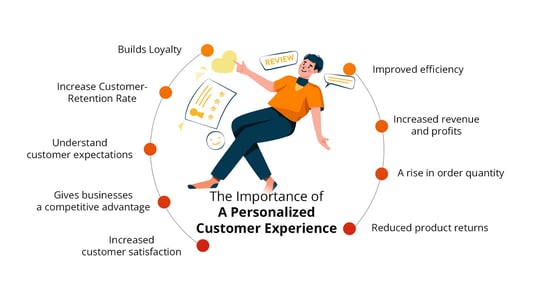
I. Importance of Customer Experience Personalization
II. Strategies for Personalizing Customer Experience
III. Benefits of Personalizing Customer Experience
IV. Implementing Personalization in Customer Service
Hey there! Today, let’s talk about the importance of customer experience personalization. Have you ever had a customer service experience that felt like it was tailor-made just for you? Maybe the representative knew your name, your previous purchase history, or even your preferences before you even said a word. That’s the power of personalization in customer experience, and it can truly make a difference in how customers perceive and interact with a brand.
Personalization in customer experience is all about creating a unique and tailored journey for each customer. By collecting and analyzing data about their preferences, behaviors, and interactions with your brand, you can create personalized experiences that make them feel seen, valued, and understood. This level of customization can help build stronger relationships with customers, increase loyalty, and drive repeat business.
Imagine walking into your favorite coffee shop and the barista already knows your usual order. It feels like a warm welcome, doesn’t it? The same concept applies to customer experience personalization in the digital world. By personalizing interactions, recommendations, and communications, you can create a seamless and enjoyable experience for your customers.
So, why is customer experience personalization so important? Well, for starters, it helps you stand out in a crowded marketplace. With so many options available to consumers, personalized experiences can set your brand apart from the competition and make a lasting impression. It also shows that you care about your customers and are willing to go the extra mile to make their experience special.
Personalization can also lead to increased customer satisfaction and loyalty. When customers feel like you understand their needs and preferences, they are more likely to return to your brand for future purchases. In fact, studies have shown that personalized experiences can increase customer satisfaction and loyalty by as much as 80%.
Another benefit of customer experience personalization is improved customer engagement. By delivering relevant and timely content to your customers, you can capture their attention and keep them coming back for more. Whether it’s personalized product recommendations, targeted promotions, or customized communications, personalization can help you connect with your customers on a deeper level.
Overall, customer experience personalization is a powerful tool that can help you build stronger relationships with your customers, increase loyalty, and drive business growth. By leveraging data and technology to create personalized experiences, you can show your customers that you value their individual needs and preferences. So, why not start exploring ways to personalize your customer experience today? Your customers will thank you for it!
“`html
Strategies for Personalizing Customer Experience
Coming soon…
Benefits of Personalizing Customer Experience
Stay tuned…
Implementing Personalization in Customer Service
More to come…
“`
Strategies for Personalizing Customer Experience
When it comes to providing exceptional customer service, personalization is key. Gone are the days of one-size-fits-all approaches. Customers want to feel valued and understood, and one way to achieve this is through personalized experiences. Here are some strategies to help you personalize your customer interactions and stand out from the competition:
1. Collect and Analyze Customer Data
The first step in personalizing the customer experience is to gather relevant information about your customers. This could include their purchase history, preferences, demographic information, and communication preferences. By analyzing this data, you can gain valuable insights into your customers’ needs and tailor your interactions accordingly.
2. Use Customer Relationship Management (CRM) Systems
CRM systems can help you track and manage customer interactions and data more effectively. By using a CRM system, you can store customer information in one centralized location, making it easier to access and utilize for personalized interactions. These systems also often have features that allow you to automate personalized communication based on customer behavior.
3. Implement Personalized Communication Channels
Utilize different communication channels to connect with your customers on a more personal level. This could include personalized emails, targeted social media campaigns, or even personalized messaging apps. By reaching out to customers through their preferred channels with tailored messages, you can enhance their overall experience with your brand.
4. Offer Personalized Recommendations
One way to show customers that you understand their needs is by offering personalized product or service recommendations. By analyzing their past purchases or browsing history, you can suggest relevant items that they may be interested in. This not only demonstrates your knowledge of their preferences but also makes the shopping experience more convenient for them.
5. Provide Proactive Customer Support
Anticipating customer needs before they even arise is a great way to personalize the customer experience. By monitoring customer behavior and trends, you can identify potential issues and address them proactively. This could include reaching out to customers with helpful tips or resources, or offering solutions to common problems before they become major concerns.
6. Create Customized Loyalty Programs
Rewarding customers for their loyalty is a great way to show appreciation and encourage repeat business. By creating personalized loyalty programs that cater to individual preferences and purchasing habits, you can make customers feel valued and incentivize them to continue engaging with your brand.
Incorporating these strategies into your customer service approach can help you build stronger relationships with your customers and differentiate your brand in a competitive marketplace. Remember, the key to successful personalization is understanding your customers’ needs and preferences, and using that knowledge to create meaningful and relevant interactions. By investing in personalized customer experiences, you can foster loyalty, increase satisfaction, and drive long-term success for your business.
Do you ever feel like companies just don’t “get” you as a customer? You’re not alone. That’s why personalized customer experiences are becoming increasingly important in today’s market.
Benefits of Personalizing Customer Experience
When you walk into a store and the salesperson greets you by name, asks about your recent purchase, and suggests products based on your past preferences, how does it make you feel? Special, right? That’s the power of personalization in customer experience.
Here are some key benefits of personalizing customer experience:
- Increased Customer Satisfaction: When customers feel like a company understands their needs and preferences, they are more likely to be satisfied with their experience. This can lead to repeat business and positive word-of-mouth referrals.
- Enhanced Brand Loyalty: Personalized experiences create emotional connections with customers, making them more likely to remain loyal to your brand. Customers who feel valued are more likely to stick around for the long haul.
- Improved Customer Retention: By personalizing interactions with customers, you can better anticipate their needs and address any issues before they become problems. This can help retain customers and reduce churn rate.
- Boosted Sales and Revenue: When customers feel like they are being heard and understood, they are more likely to make additional purchases. Personalized recommendations and offers can drive sales and increase revenue.
Personalizing customer experience is not just a nice-to-have—it’s a must-have in today’s competitive market. Customers have come to expect personalized interactions with companies, and those that don’t deliver may risk losing business to competitors who do.
So how can you start personalizing your customer experience? It’s all about leveraging data and technology to better understand your customers’ preferences and behavior. By collecting and analyzing customer data, you can tailor your interactions and offerings to meet their needs.
Remember, personalization is not just about using a customer’s name in an email—it’s about truly understanding their wants and needs and delivering a customized experience that makes them feel valued and appreciated.
By investing in personalization, you can create loyal customers who will keep coming back for more. So don’t miss out on the benefits of personalizing your customer experience—it’s a win-win for both you and your customers.
“`html
- Increased Customer Satisfaction: When customers feel like a company understands their needs and preferences, they are more likely to be satisfied with their experience. This can lead to repeat business and positive word-of-mouth referrals.
- Enhanced Brand Loyalty: Personalized experiences create emotional connections with customers, making them more likely to remain loyal to your brand. Customers who feel valued are more likely to stick around for the long haul.
- Improved Customer Retention: By personalizing interactions with customers, you can better anticipate their needs and address any issues before they become problems. This can help retain customers and reduce churn rate.
- Boosted Sales and Revenue: When customers feel like they are being heard and understood, they are more likely to make additional purchases. Personalized recommendations and offers can drive sales and increase revenue.
“`
Implementing Personalization in Customer Service
So, you’ve heard all about the importance of personalizing customer experience and you’re ready to take the plunge. But where do you start? How do you actually implement personalization in your customer service strategy? Don’t worry, I’ve got you covered!
1. Understand Your Customers:
The first step in implementing personalization in customer service is to truly understand your customers. Take the time to gather data on their preferences, behaviors, and past interactions with your brand. This will help you tailor your customer service approach to meet their specific needs and expectations.
2. Use Customer Relationship Management (CRM) Software:
Invest in a good CRM software that can help you keep track of customer data, interactions, and preferences. This will allow you to provide more personalized service to your customers, whether it’s through targeted marketing campaigns or customized product recommendations.
3. Train Your Customer Service Team:
Your customer service team plays a crucial role in delivering personalized experiences to your customers. Make sure they are well-trained in using the CRM software, understanding customer data, and providing tailored solutions to individual customers. Encourage them to go the extra mile to make each interaction unique and memorable.
4. Leverage Automation:
While personalization is all about human touch, automation can help streamline the process and make it more efficient. Use automation tools to send personalized emails, messages, or notifications based on customer behavior and preferences. This will help you stay connected with your customers without overwhelming your team.
5. Measure and Analyze Results:
Implementing personalization in customer service is an ongoing process that requires constant monitoring and adjustments. Use analytics tools to track the impact of your personalized efforts and gather feedback from customers. This will help you refine your approach and continue to improve the customer experience.
Remember, personalization is not just a buzzword – it’s a powerful tool that can help you build stronger relationships with your customers and drive loyalty. By taking the time to understand your customers, investing in the right technology, training your team, and measuring results, you can create personalized experiences that set you apart from the competition. So, go ahead and start personalizing your customer service – your customers will thank you for it!










Comments